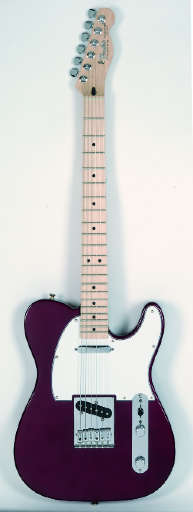MusicRadar Verdict
A well-built, gig-ready instrument.
Pros
- +
Great value. Beefier pickups. Player-friendly neck.
Cons
- -
The resolutely modern Telecaster feel isn't to everyone's taste.
MusicRadar's got your back
Talk to anyone in music retail and they are likely to tell you that Fender's Mexican Strats and Teles are comfortably among their biggest sellers.
A combination of solid build quality, great value for money and that all-important Fender logo on the headstock ensure their enduring success with guitarists.
Despite this, Fender is keen not to rest on its laurels and instead keeps the range bang up to date and a nose ahead of the competition.
As a result, perhaps even the gap between these instruments and the more expensive American Series is narrowing.
Overview
It's soon clear that for our left hand at least, there is very little difference in the playing experience with the Telecaster, as the neck's feel and profile is virtually identical, and therefore just as appealing as the Stratocaster.
The midnight wine finish is a subtle metallic shade that proved to be rather popular in the Guitarist office, even if it isn't exactly the most iconic choice of Telecaster livery.
Just like the Stratocaster, the class of 2006 Standard Tele gets larger frets, internal shielding, a couple of new finishes and a gigbag.
However, the Telecaster obviously lacks the Strat's synchronised vibrato so instead of a chunkier bridge block, the Tele's most tone-impacting update comes in the shape of a pair of hotter new pickups, promising a more authoritative take in the guitar's three pickup positions.
Both Stratocaster and Telecaster feature modern sealed tuners, although we feel that the more diminutive proportions of the Telecaster headstock are better suited aesthetically to vintage-style Kluson-a-likes.
Elsewhere, the six-saddle bridge is a common fixture on modern Telecasters, and while not as vibey as a trio of brass saddles, they certainly intonate more accurately.
Other appointments are standard fare at this position in the Fender catalogue, and the result is a guitar that does what it needs to with the minimum of fuss.
Sounds
Switching to the Telecaster with an identical amp tone to its sibling, its new bridge pickup is more balanced; a little firmer in the bass department and a little less shrill on top.
The new hotter pickups have a slightly raunchier character, while still retaining the essence of their identity and not sounding too overwound.
The neck unit is certainly a little glassier than its warmer Strat equivalent, and more suited to chiming arpeggiated accompaniment than taking centre stage for bluesy lead solos, which is where the more curvaceous Strat shines.
Although there have been a number of major exceptions over the years, with both instruments side by side it's easy to see how the Telecaster has most often been the rhythm guitarist's workhorse and the Stratocaster the lead instrument.
All three main sounds in the Telecaster's armoury are fantastic balanced rhythm sounds. That said, it's easy to forget just how versatile a Telecaster's sweet neck pickup can be, excelling at delay-adorned atmospherics as readily as swampy riffing.
Guitarist is the longest established UK guitar magazine, offering gear reviews, artist interviews, techniques lessons and loads more, in print, on tablet and on smartphones Digital: http://bit.ly/GuitaristiOS If you love guitars, you'll love Guitarist. Find us in print, on Newsstand for iPad, iPhone and other digital readers
“A fabulous trip through all eight songs by 24 wonderful artists and remixers... way beyond anything I could have hoped for”: Robert Smith announces new Cure remix album
“He knows what I'm thinking and feeling before I even know it": Billie Eilish suggests that she and brother Finneas can read each other's minds
“A purpose-built solution for bassists seeking unparalleled sound-shaping capabilities”: Darkglass Electronics unveils the Anagram Bass Workstation – a state-of-the-art multi-effects for bass guitar with neural amp model support and a 7” touchscreen











